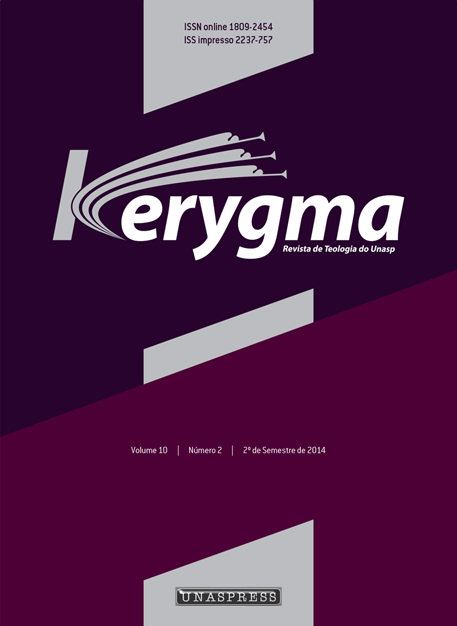Resumen
Grande parte da vida sociorreligiosa que os cristãos exteriorizam e objetivam ao interagir com Deus através da adoração congregacional requer uma análise interpretativa. O sentido religioso que o cristão encontra no ritual de adoração, baseado na consciência religiosa intersubjetiva bíblica da relação dialógica Deus-homem, permite avançar na compreensão da formação e conservação de fé, isto é, na construção e atualização de uma consciência religiosa intersubjetiva. Para isso, o presente artigo usa o método teológico de Bernard Lonergan e os quatro níveis de consciência (empírico, intelectual, racional e responsável), conectado com o modelo pastoral de ver, julgar e agir; e com os três tipos ideais de Jürgen Habermas sobre o perfil ético-professional do cientista social (técnico, prático e dialógico).
Palavras-chave: Consciência Religiosa Intersubjetiva; Níveis de Consciência; Consciência Bíblica.
Abstract: Much of the socio-religious life that Christians externalized and are intended to interact with God through congregational worship requires an interpretative analysis. The religious sense that the Christian finds in ritual worship, based on the biblical religious consciousness of intersubjective dialogic relationship God-man, up through the understanding of the formation and preservation of faith, that is, in building and updating an inter-subjective religious consciousness. In order to do this, the present article uses the theological method of Bernard Lonergan and the four levels of consciousness (empirical, intellectual, rational and responsible), connected with the pastoral model to see, judge and act; and the three ideal types of Jürgen Habermas on the ethical and professional profile of the social scientist (technical, practical and dialogical).
Keywords: Religious inter-subjective consciousness; Awareness levels; Biblical consciousness.
Citas
AUSTIN MILLÁN, T. Dos momentos en la teoría de Jurgen Habermas, 2000. Disponível em: http://bit.ly/ZWZRSu.
BERGER, P.; LUCKMANN, T. La construcción social de la realidad. Buenos Aires: Amorrortu editores, 1999.
GEERTZ, C. La interpretación de las culturas. Barcelona: Editorial Gedisa, 2005.
HABERMAS, J. Teoría de la Acción Comunicativa. Madrid: Taurus, 1987.
MARZAL, M. Tierra encantada. Tratado de antropología religiosa de América Latina. Lima: Editorial Trota, 2002.
RICOEUR, P. El mal. Un desafío a la filosofía y a la teologia. Buenos Aires: Amorrortu editores, 2007.
RITZER, G. Teoría sociológica contemporânea. Madrid: McGraw-Hill, 1993.
SCANNONE, J. C. Religión y nuevo pensamento: hacia una filosofía de la religión para nuestro tiempo desde América Latina. Barcelona: Anthropos Editorial, 2005.
Los autores que publican en la revista Kerygma deben estar de acuerdo con los siguientes términos:
- Una vez aceptados para su publicación, los derechos de autor de los artículos se transfieren automáticamente a la revista Kerygma.
- Todo material utilizado en el texto que tenga derechos de autor de terceros debe estar debidamente referenciado.
- Los autores también deben tener los derechos de reproducción de las imágenes y tablas en su material, en caso de ser necesario.
- Los autores garantizan que el texto presentado es de su autoría exclusiva y no ha sido presentado y/o publicado en ningún otro lugar.
- Las opiniones, ideas y conceptos expresados en los textos son responsabilidad exclusiva de sus autores y no representan necesariamente la opinión de la revista Kerygma.
- Se reserva a los editores el derecho de realizar ajustes de texto y adaptación a las normas de publicación.
- Los autores mantienen los derechos de autor y otorgan a la revista el derecho de primera publicación, con el trabajo simultáneamente licenciado bajo Creative Commons Atribución-NoComercial 4.0 Internacional, que permite compartir el trabajo con el reconocimiento de la autoría y la publicación inicial en esta revista. Esta licencia permite que otros reutilicen, adapten y creen a partir de su trabajo con fines no comerciales, y aunque los nuevos trabajos deben darle crédito adecuado y no pueden ser utilizados con fines comerciales, los usuarios no necesitan licenciar esos trabajos derivados bajo los mismos términos.
- Los autores están de acuerdo con la reproducción libre de su material por parte de la revista Kerygma, que puede adaptar, modificar, condensar, resumir, reducir, compilar, ampliar, alterar, mezclar con otros contenidos, incluir imágenes, gráficos, objetos digitales, infografías y enlaces, ilustrar, diagramar, fraccionar, actualizar, traducir y realizar cualquier otra transformación, requiriendo la participación o autorización expresa de los autores.
- Los autores aceptan que la revista Kerygma puede distribuir los artículos a través de cables, fibra óptica, satélites, ondas o cualquier otro sistema que permita el acceso del usuario en tiempo y lugar determinados, ya sea de forma gratuita o mediante sistemas de pago. La revista Kerygma también puede incluir el trabajo en bases de datos, físicas o virtuales, archivar en formato impreso, almacenar en computadoras, sistemas en la nube, microfilmar y otras formas de archivado actuales o que aún puedan ser desarrolladas, con o sin fines de lucro.
- Los autores tienen permiso para celebrar contratos adicionales por separado para la distribución no exclusiva de la versión del trabajo publicado en esta revista (por ejemplo, publicar en un repositorio institucional o como capítulo de un libro), con reconocimiento de la nueva publicación de que el artículo se publicó originalmente en esta revista.
- La revista Kerygma es titular de los derechos de todos los trabajos publicados por ella. La reproducción completa de estos textos en otras publicaciones, para cualquier otro propósito y por cualquier medio, requiere la autorización por escrito del editor. Lo mismo se aplica a las reproducciones parciales, como resúmenes, resúmenes en otros idiomas, porciones de más de 500 palabras del texto, tablas, figuras, ilustraciones, etc.
- Los autores tienen permiso y se les anima a publicar y distribuir su trabajo en línea (por ejemplo, en repositorios institucionales o en su página personal) en cualquier momento antes o durante el proceso editorial, ya que esto puede generar cambios productivos y aumentar el impacto y la citación del trabajo publicado [consulte "El efecto del acceso abierto y las descargas ('hits') en el impacto de las citas: una bibliografía de estudios" (“The effect of open access and downloads ('hits') on citation impact: a bibliography of studies”).

